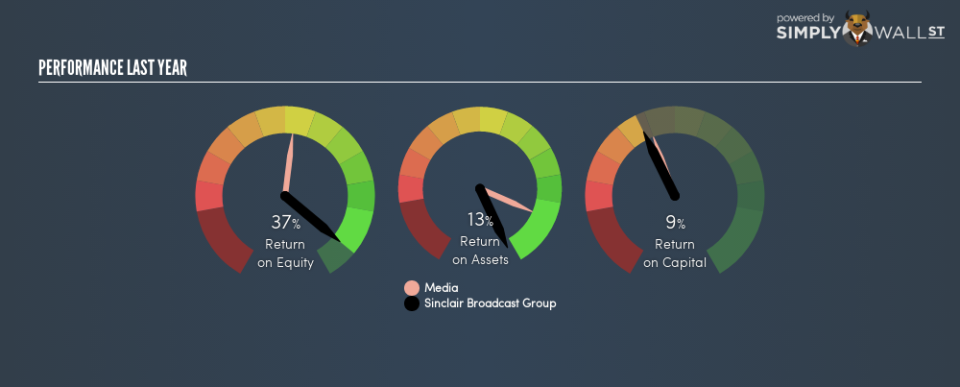How Do Sinclair Broadcast Group, Inc.’s (NASDAQ:SBGI) Returns On Capital Compare To Peers?

Today we are going to look at Sinclair Broadcast Group, Inc. (NASDAQ:SBGI) to see whether it might be an attractive investment prospect. Specifically, we’re going to calculate its Return On Capital Employed (ROCE), in the hopes of getting some insight into the business.
First, we’ll go over how we calculate ROCE. Then we’ll compare its ROCE to similar companies. Finally, we’ll look at how its current liabilities affect its ROCE.
Understanding Return On Capital Employed (ROCE)
ROCE measures the amount of pre-tax profits a company can generate from the capital employed in its business. All else being equal, a better business will have a higher ROCE. In brief, it is a useful tool, but it is not without drawbacks. Author Edwin Whiting says to be careful when comparing the ROCE of different businesses, since ‘No two businesses are exactly alike.’
So, How Do We Calculate ROCE?
Analysts use this formula to calculate return on capital employed:
Return on Capital Employed = Earnings Before Interest and Tax (EBIT) ÷ (Total Assets – Current Liabilities)
Or for Sinclair Broadcast Group:
0.089 = US$480m ÷ (US$6.6b – US$601m) (Based on the trailing twelve months to September 2018.)
So, Sinclair Broadcast Group has an ROCE of 8.9%.
See our latest analysis for Sinclair Broadcast Group
Want to help shape the future of investing tools and platforms? Take the survey and be part of one of the most advanced studies of stock market investors to date.
Is Sinclair Broadcast Group’s ROCE Good?
ROCE is commonly used for comparing the performance of similar businesses. We can see Sinclair Broadcast Group’s ROCE is around the 8.2% average reported by the Media industry. Separate from how Sinclair Broadcast Group stacks up against its industry, its ROCE in absolute terms is mediocre; relative to the returns on government bonds. It is possible that there are more rewarding investments out there.
It is important to remember that ROCE shows past performance, and is not necessarily predictive. ROCE can be deceptive for cyclical businesses, as returns can look incredible in boom times, and terribly low in downturns. ROCE is only a point-in-time measure. Future performance is what matters, and you can see analyst predictions in our free report on analyst forecasts for the company.
Sinclair Broadcast Group’s Current Liabilities And Their Impact On Its ROCE
Short term (or current) liabilities, are things like supplier invoices, overdrafts, or tax bills that need to be paid within 12 months. The ROCE equation subtracts current liabilities from capital employed, so a company with a lot of current liabilities appears to have less capital employed, and a higher ROCE than otherwise. To check the impact of this, we calculate if a company has high current liabilities relative to its total assets.
Sinclair Broadcast Group has total liabilities of US$601m and total assets of US$6.6b. As a result, its current liabilities are equal to approximately 9.1% of its total assets. With low levels of current liabilities, at least Sinclair Broadcast Group’s mediocre ROCE is not unduly boosted.
What We Can Learn From Sinclair Broadcast Group’s ROCE
If performance improves, then Sinclair Broadcast Group may be an OK investment, especially at the right valuation. You might be able to find a better buy than Sinclair Broadcast Group. If you want a selection of possible winners, check out this free list of interesting companies that trade on a P/E below 20 (but have proven they can grow earnings).
For those who like to find winning investments this free list of growing companies with recent insider purchasing, could be just the ticket.
To help readers see past the short term volatility of the financial market, we aim to bring you a long-term focused research analysis purely driven by fundamental data. Note that our analysis does not factor in the latest price-sensitive company announcements.
The author is an independent contributor and at the time of publication had no position in the stocks mentioned. For errors that warrant correction please contact the editor at editorial-team@simplywallst.com.


